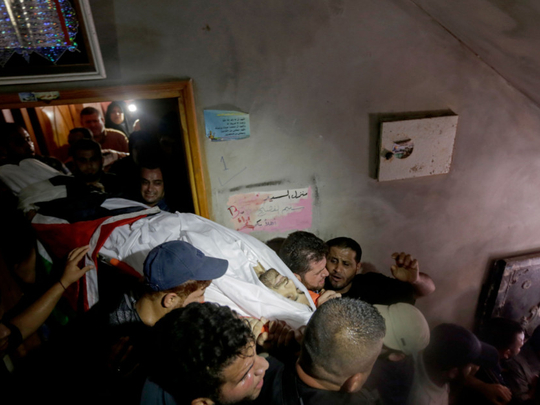
Gaza: Israeli occupation troops fired live rounds and tear gas as thousands of Palestinians protested near the Gaza border fence on Friday, and at least four demonstrators were killed, including a teenage boy, with over 600 wounded, Gaza health officials said.
More than 100 of the wounded, including a photographer for the French news agency Agence France-Presse, were hit by live fire, the officials added, as the demonstrators burned tyres, threw stones and flew flaming kites in the latest in a series of mass protests to call attention to a decade-old blockade of Gaza by Israel and Egypt.
The march coincided with the annual “Jerusalem Day,” instituted by Iran to protest Israeli regime rule of the holy city.
In the capitals of Iran and Iraq, thousands of Shiite Muslims marked Jerusalem Day with protests, with some chanting “Death to Israel” or burning Israeli flags and effigies of President Donald Trump.
Since the near-weekly protests began on March 30, at least 125 unarmed Palestinians have been killed and over 3,800 wounded by Israeli occupation regime fire.
Among the dead on Friday was 15-year-old Haitham Al Jamal. His family said he was taking part in a protest in Rafah, in southern Gaza, when he was shot. A total of 12 children under age 16 have been killed in the protests.
French news agency Agence France-Presse said one of its photographers, Mohammad Abed Al Baba, was wounded at a mass rally after Israeli regime forces opened fire. AFP said Al Baba was wearing a press vest and helmet about 200 metres from the border when hurt.
It said he was wounded below the knee while trying to take a photo of a wounded protester after occupation troops opened fire. The photographer’s injury was not life-threatening, but he was to undergo surgery.
After Muslim prayers at noon Friday, thousands of Gaza residents streamed towards five protest tent camps that were erected more than two months ago, each several hundred metres from the fence. From there, smaller groups walked closer to it.
Israeli regime troops fired volleys of tear gas, including from drones, that sent protesters running for cover.
One man with a bullhorn shouted, “America is the biggest evil.”
At one point, seven activists in black-and-white striped shirts meant to resemble concentration camp uniforms from the Second World War approached the fence.
“We want to remind the world that the Israeli occupation is committing the same massacres that the Nazis committed,” said activist Ahmad Abu Artima.
The mass protests have been aimed at a border blockade imposed by Israel in 2007, after Hamas overran the territory. The marchers have also pressed demands for a “right of return” for descendants of Palestinian refugees to ancestral homes in what is now Israel.
More than 700,000 Palestinians were expelled or fled in the 1948 Mideast war over Israel’s creation. Two-thirds of Gaza’s 2 million residents are descendants of refugees.
Protester Fadi Saleh said the frequent marches have helped revive sympathies in the Arab world for the Palestinians, but that more could be done.
“We need real Arab support and solidarity with our cause,” said Saleh, a student of Arabic literature who wore a medical mask against the tear gas.
Israel’s use of lethal force against the protesters has drawn international criticism. Rights groups have said Israel’s open-fire rules are unlawful.
Growing despair in Gaza over blockade-linked hardships, including daily power cuts and rising poverty, have driven turnout.
The Jerusalem Day protests are being held each year on the last Friday of Ramadan. The day is known in Arabic as “Al Quds Day,” a reference to the city’s historic Arabic name.
Israel captured East Jerusalem in the 1967 Mideast war and annexed it to its capital, a move not recognised by most of the international community. Israel’s current regime has said it will not accept a partition of the city as part of a peace deal with the Palestinians.
Tensions were further heightened last month after the US moved its embassy from Tel Aviv to occupied Jerusalem in a step seen by both Israel and the Palestinians as siding with Israel on the most sensitive issue in the conflict.












